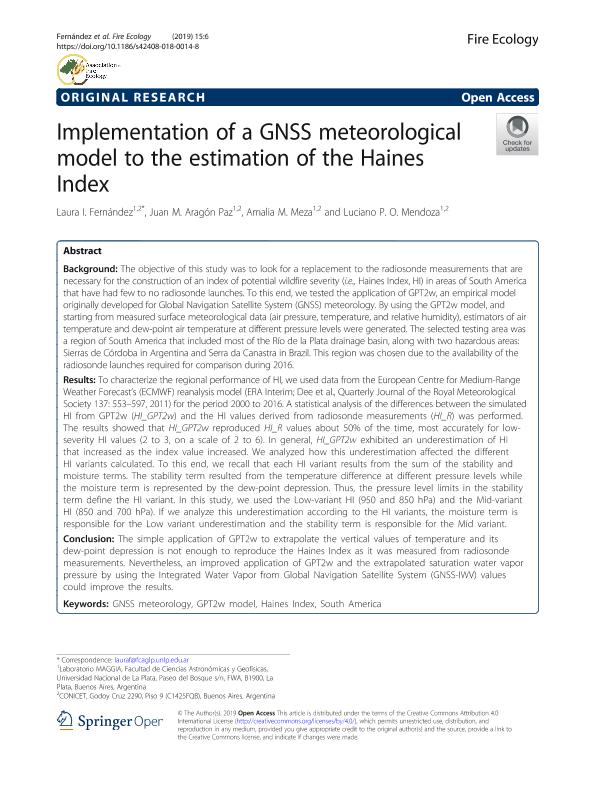Artículo
Implementation of a GNSS meteorological model to the estimation of the Haines Index
Fernandez, Laura Isabel ; Aragón Paz, Juan Manuel
; Aragón Paz, Juan Manuel ; Meza, Amalia Margarita
; Meza, Amalia Margarita ; Mendoza, Luciano Pedro Oscar
; Mendoza, Luciano Pedro Oscar
 ; Aragón Paz, Juan Manuel
; Aragón Paz, Juan Manuel ; Meza, Amalia Margarita
; Meza, Amalia Margarita ; Mendoza, Luciano Pedro Oscar
; Mendoza, Luciano Pedro Oscar
Fecha de publicación:
22/05/2019
Editorial:
Springer
Revista:
Fire Ecology
e-ISSN:
1933-9747
Idioma:
Inglés
Tipo de recurso:
Artículo publicado
Clasificación temática:
Resumen
Background: The objective of this study was to look for a replacement to the radiosonde measurements that are necessary for the construction of an index of potential wildfire severity (i.e., Haines Index, HI) in areas of South America that have had few to no radiosonde launches. To this end, we tested the application of GPT2w, an empirical model originally developed for Global Navigation Satellite System (GNSS) meteorology. By using the GPT2w model, and starting from measured surface meteorological data (air pressure, temperature, and relative humidity), estimators of air temperature and dew-point air temperature at different pressure levels were generated. The selected testing area was a region of South America that included most of the Río de la Plata drainage basin, along with two hazardous areas: Sierras de Córdoba in Argentina and Serra da Canastra in Brazil. This region was chosen due to the availability of the radiosonde launches required for comparison during 2016. Results: To characterize the regional performance of HI, we used data from the European Centre for Medium-Range Weather Forecast’s (ECMWF) reanalysis model (ERA Interim; Dee et al., Quarterly Journal of the Royal Meteorological Society 137: 553–597, 2011) for the period 2000 to 2016. A statistical analysis of the differences between the simulated HI from GPT2w (HI_GPT2w) and the HI values derived from radiosonde measurements (HI_R) was performed. The results showed that HI_GPT2w reproduced HI_R values about 50% of the time, most accurately for low-severity HI values (2 to 3, on a scale of 2 to 6). In general, HI_GPT2w exhibited an underestimation of HI that increased as the index value increased. We analyzed how this underestimation affected the different HI variants calculated. To this end, we recall that each HI variant results from the sum of the stability and moisture terms. The stability term resulted from the temperature difference at different pressure levels while the moisture term is represented by the dew-point depression. Thus, the pressure level limits in the stability term define the HI variant. In this study, we used the Low-variant HI (950 and 850 hPa) and the Mid-variant HI (850 and 700 hPa). If we analyze this underestimation according to the HI variants, the moisture term is responsible for the Low variant underestimation and the stability term is responsible for the Mid variant. Conclusion: The simple application of GPT2w to extrapolate the vertical values of temperature and its dew-point depression is not enough to reproduce the Haines Index as it was measured from radiosonde measurements. Nevertheless, an improved application of GPT2w and the extrapolated saturation water vapor pressure by using the Integrated Water Vapor from Global Navigation Satellite System (GNSS-IWV) values could improve the results.
Palabras clave:
GNSS METEOROLOGY
,
GPT2W MODEL
,
HAINES INDEX
,
SOUTH AMERICA
Archivos asociados
Licencia
Identificadores
Colecciones
Articulos(CCT - LA PLATA)
Articulos de CTRO.CIENTIFICO TECNOL.CONICET - LA PLATA
Articulos de CTRO.CIENTIFICO TECNOL.CONICET - LA PLATA
Citación
Fernandez, Laura Isabel; Aragón Paz, Juan Manuel; Meza, Amalia Margarita; Mendoza, Luciano Pedro Oscar; Implementation of a GNSS meteorological model to the estimation of the Haines Index; Springer; Fire Ecology; 15; 6; 22-5-2019; 1-18
Compartir
Altmétricas



